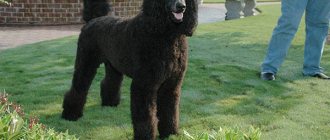The Labrador is a dog of medium height and heavy build.
Distinctive features are a large head, powerful paws, a strong neck and a wide chest.
Height at withers – 50-57 cm, weight 30-40 kg, life expectancy 13-15 years.
The dog has a soft and good-natured character, loves children and takes other pets well.
Labradors are very sociable, intelligent, and easily adapt to their owner’s mood.
Life expectancy for boys and girls at home
According to official data, the life expectancy of a Labrador is from 13 to 15 years.
But, this figure may fluctuate depending on many factors.:
- Heredity.
- Conditions of content.
- Food quality.
- Number of births (for bitches), etc.
If a dog has good heredity and receives proper care, then the probability that it will live to a ripe old age is 90-95% . In this case, the maximum lifespan will be 15 years.
If conditions are not ideal, the lifespan will be 8-9 years. This figure is the minimum.
It is believed that females live longer than males by 1-2 years . But in practice this is not the case. The fact is that each birth of puppies wears out the bitch’s body, and therefore reduces life expectancy.
According to experienced breeders, Labrador retriever males and females live approximately the same number of years in good conditions.
Features of training
Labrador loves to play with people, so the owner must show the dog interest in the game. From a young age you need to learn to direct the dog’s restless activity in the right direction; this can be done with the help of special classes.
For training you need to choose a free area
If classes are held with a puppy, it is important that they are short, since the baby will not be able to concentrate on the same thing for a long time. You should not conduct the lesson in a bad mood or in a hurry - there will be no results
Important! Use a toy as a reward; it is necessary that such a thing is used exclusively for training.
Treats are also suitable, cut them into small pieces so that the puppy can immediately swallow them, use such treats only during classes. When training, constantly move around the area. Don't be discouraged if your pet can't complete the exercise right away; praise him for his effort.
The Labrador is suitable for athletes, teenagers and anyone who loves an active lifestyle; he will happily play, run and share the joy of a walk. Unlike other breeds, the Labrador is not at all aggressive. Even large families have such a pet, because Labradors love children and other pets very much. This dog is suitable for people with disabilities and will be an excellent guide dog.
How many years has he lived on the street?
Before answering this question, it should be said that a Labrador is not a dog for which life in an enclosure or kennel is the norm.
The dog's body is not adapted to cold winters and bad weather .
This means that living outdoors will negatively affect your pet’s health. Also important are the attitude towards the dog, the quality of food, timely examination by a veterinarian, and so on.
Statistics say that the life expectancy of a Labrador living on the street will be no more than 10 years..
Expert opinion
Kozhevin Semyon Kirillovich
Expert dog handler.
“Labradors are generally energetic, active dogs that need regular walks and exercise. Otherwise, they develop heart problems, arthritis, and excess weight. And this can seriously affect the pet's life expectancy. With proper care and good conditions, the life expectancy of a Labrador can reach up to 15 years.”
Labrador: life expectancy, what factors influence a dog’s longevity
To prolong the life of your four-legged friend, you need to know what factors negatively affect his health. Knowing what can lead to the imminent death of an animal, it is much easier to protect it from harmful effects.
Poor nutrition
Nutrition is the most significant factor influencing a pet’s lifespan. Junk food reduces immunity and also becomes a source of disease. For example, ready-made economy class food, which some owners buy to save money, can lead to an allergic reaction, stomach and skin diseases. By the way, dogs’ bodies also experience a negative load from cheap sausages, stewed meat or leftover human food.
Lack of physical activity
A house where a Labrador spends time passively will eventually become boring for him, and constant stay in an apartment is fraught with obesity, problems with the cardiovascular, nervous system and skeleton for the pet.
Representatives of this breed are prone to obesity, so it is important to provide them with physical activity.
Diseases of dogs of different breeds
Labradors can suffer from genetically transmitted diseases. Among them are diseases such as:
- Hip dysplasia. A number of factors can provoke the disease: quality of food, environment, growth rate, damage to the pet’s ball-and-socket joint.
- Panosteitis. This disease can occur in puppies under the age of one and a half years or in older pets; it is caused by an inflammatory process in the internal canal of long bones.
- Elbow dysplasia. The onset of the disease is signaled by sudden lameness of the puppy before he reaches the age of 8 months.
- Osteochondrosis. Puppies aged 5 to 18 months are at risk. Males are more often affected by the disease.
- Licking granuloma. It is expressed in the formation of ulcers on the leg of a four-legged friend. Labradors suffer from these diseases more often than other breeds.
- Progressive retinal atrophy. The disease affects both eyes, after which the Labrador loses vision.
- Cataract. The disease is transmitted along the genetic line and is expressed in clouding of the lens of the eyes.
- Epilepsy. The disease is rare and appears in pets aged from six months to 3 years.
Labradors are susceptible to genetically transmitted diseases.
Castration and sterilization
Spaying and neutering can negatively impact a Labrador's life expectancy. The need to give birth to offspring is a problem for Labrador owners, of course, if the puppy was not purchased for these purposes. It is best to contact a specialist who, instead of castration and sterilization, will perform an operation during which the male's testes will be removed, and the female's ovaries and uterus will be removed.
Important! Dogs that have not undergone surgery are at risk of developing diseases related to the reproductive system.
Age compared to human years
Life years of a Labrador retriever converted to human age up to one year:
| Puppy age up to one year | Person's age |
| 1 month | 6 months |
| 2 months | 1 year |
| 3 months | 2 years |
| 4 months | 3 years |
| 5 months | 4 years |
| 6 months | 5 years |
| 7 months | 7 years |
| 8 months | 9 years |
| 9 months | 10 years |
| 10 months | 11 years |
| 11 months | 13 years |
After a year:
| Puppy age after one year | Person's age (years) |
| 1 | 14 |
| 2 | 25 |
| 3 | 30 |
| 4 | 36 |
| 5 | 40 |
| 6 | 42 |
| 7 | 49 |
| 8 | 56 |
| 9 | 63 |
| 10 | 65 |
| 11 | 71 |
| 12 | 75 |
| 13 | 80 |
| 14 | 85 |
| 15 | 87 |
Useful video
From the video you will learn everything about the Labrador dog breed:
Rate the author's article:
10 ratings, average: 4.50 out of 5
Loading…
- How long do Labradors live?
- Comparison of the ages of Labradors and humans
- What affects the lifespan of a Labrador retriever?
- How to help your Labrador live a long life
Labrador retrievers are loved all over the world. These dogs are very kind, smart, playful, and most importantly, they are not at all aggressive. But for potential owners, not only the dog’s character traits play a significant role, but also its life expectancy. In this article we will figure out what age the cute Labradors are allowed to live.
How to determine age?
In order to determine age, you need to know the following:
- At 20-25 days of life, the puppy already has milk teeth.
- Milk teeth are replaced at the age of 3-4 months.
- At one year the dog has a full set of teeth. The front incisors have three lobes resembling a trefoil corolla. With age, these blades wear out.
- By the age of two, these blades are completely worn out.
- At the 3rd year of life, the tops of the Dachshund's middle incisors wear off, and closer to 3 years, the teeth begin to turn yellow and fade.
- At the 4th year, the central and middle incisors are completely smoothed.
- Closer to 4 years, the incisors of the upper jaw are erased almost completely.
- At the age of 5, the dog’s fangs begin to grow dull.
- By the age of 6, a dachshund’s teeth become yellow, and the blades of all incisors are completely worn out, the canines are rather blunt and slightly worn.
- By 8-10 years of age, the same thing happens with the teeth on the lower jaw.
- After 10 years, a dog's teeth begin to fall out.
Another sign of determining age is the appearance of gray hair on the pet's face . It begins to appear closer to 6-7 years.
In addition, in old age, the dog's eyes become sunken, and the pupils dilate and become cloudy.
Breed standards
Before purchasing a Labrador Retriever, get to know what a Labrador looks like.
According to the Fédération Cynologique Internationale, an adult Labrador has the following breed standards:
- the skull is clearly defined, wide, without expressive cheekbones, wedge-shaped. The forehead is slightly convex, blends steeply into the muzzle, and there is a small furrow.
- the muzzle is large and powerful, the nostrils and nose are large and wide;
- the jaws are strong, neat, slightly rounded;
- the nose is straight and even, slightly tapering towards the edge;
- the brow ridges are expressive, but not heavy;
- cheeks are taut, without folds;
- The bite is regular and scissor-shaped. The teeth fit tightly together and are even.
- eyes are small, usually brown;
- the ears are medium in size, triangular in shape, located slightly behind the muzzle, close to the head;
- the neck is strong, lean and powerful; back straight; loin short; the chest is wide and deep; barrel-shaped ribs;
- tail of moderate length, straight; has a larger diameter at the base, narrowing towards the edge; the hanger is missing; the coat is short but thick;
- paws are straight; the hind ones are more developed, have a larger bend angle; metatarsus short; paws of medium size, rounded; fingers pressed tightly, pillows large;
- the fur is hard and short; there is a soft undercoat.
- the height of the dog at the withers is 56-57 cm, girls are several cm less;
- Boys' weight ranges from 27 kg to 40 kg, girls weigh up to 35 kg.
An adult Labrador can have several colors:
- black, a spot on the chest is allowed;
- wheat: from ivory to fox red;
- Brown: The Chocolate Retriever may have a light spot on the chest as standard.
Main causes of premature death
The most common causes of death among Labradors:
- Gastric volvulus. This is an acute dilatation of the stomach due to weakness of its wall. The disease is characterized by an increase in the size of the stomach (bloating), which entails compression of the diaphragm and impaired circulation in the internal organs, which leads to death.
- Tracheal collapse is a chronic disease with common causes. It is characterized by a narrowing of the lumen of the air tube that connects the larynx and lungs (trachea).
- Tumor of the spleen and its rupture. With any tumor of the spleen, rupture of the tumor can often be observed. Even the most minor injuries can cause this.
- Entry of a foreign body into the throat. It can be anything: bones, wood chips, broken glass, pieces of toys, etc. In this case, the animal lies with its mouth open, breathing is difficult, and suffocation develops.
- Heart diseases. The most common of them is delegation cardiomyopathy.
- Poisoning. In most cases, dogs are poisoned to kill mice and rats.
Advice from veterinarians
Forbidden:
- pull anything out of the labrador's mouth until 8 months, as the bite will deteriorate;
- give sharp bird bones. Possible internal bleeding;
- give sweets and food that is too hot or cold. The optimal food temperature is 30-35 °C;
- feed from the floor. Need a height stand;
- wash your dog frequently;
- provide your Labrador with a cool, hard place to lie down;
- swing at the puppy;
- take long walks immediately after meals;
- put a harness on the puppy;
- allow the dog to jump from the sofa, chair, etc.;
- ride children on the back of a dog.
A week before vaccination, it is necessary to take an anthelmintic drug.
Important:
- first vaccination at 2 months (give an anthelmintic drug 7-10 days before);
- second vaccination after 3-4 weeks;
- first walk 14 days after the last vaccination;
- further vaccinations once a year;
- a puppy’s normal temperature is 38-38 °C;
- vomiting, diarrhea, and rash are signs of infection.
When answering the question of how many years do retrievers live, experienced breeders and veterinarians argue that, regardless of gender, in favorable conditions, the life prognosis is optimal by generally accepted standards and allows the dog to live a full, eventful life.
How to extend the life of a pet?
What to do to make your Labrador live as long as possible:
- After your pet celebrates its seventh birthday, try to give it low-calorie food, as older animals become lazy, sleep a lot and spend 3 times less energy than young dogs.
- Give your dog digestive aids, as older dogs often suffer from constipation, indigestion and other gastrointestinal disorders.
- Be sure to give your dog vitamins and micronutrient supplements throughout his life.
- Walk your dog daily, but try to protect him from overexertion. Do not allow the dog to run a lot, jump from heights or walk on uneven surfaces. Remember - the joints and musculoskeletal system of an older dog are very vulnerable.
- Visit your veterinarian at least twice a year. This is necessary in order to detect diseases in the early stages and take timely measures.
- Bathe your dog less often and protect it from occasional drafts.
CAREFULLY!
If the dog begins to limp, this may indicate that it is developing arthritis, and this is a reason to consult a veterinarian.
Proper nutrition
The basis of the Labrador's diet is meat products. The large size of the dog requires a fairly large amount of food, rich in proteins, vitamins and microelements.
Labrador is allowed to give:
- Chicken fillet.
- Beef and veal tenderloin.
- Turkey poultry.
- Horse meat.
- Rabbit meat.
- Offal.
Another important component in a Labrador's diet is porridge . It could be buckwheat porridge, oatmeal or rice.
In addition to cereals and meat, the dog needs to receive foods rich in nutrients, vitamins and macroelements.
This:
- Sea fish.
- Boiled eggs (2-3 per week).
- Dairy products.
- Vegetables.
All meat products that a dog receives must be heat-treated to avoid infecting the pet with worms..
Quality content
Basic rules for quality Labrador care:
- Be sure to give your pet all necessary vaccinations. Moreover, the vaccine that is administered to the dog must be of high quality, and the vaccinations themselves must be done on time.
- Be sure to walk your dog at least 3 hours a day (1.5 hours in the morning and the same in the evening).
- Do not overfeed your pet, because Labradors are prone to obesity, and this can lead to many different diseases. Under no circumstances should you give your dog: sausage, smoked meats, candy, flour products, sweets and other prohibited foods.
- Be sure to take care of your dog's coat, bathe it regularly, use special shampoos, conditioners and other care products. Groom your dog regularly to prevent tangles from appearing.
- Give your pet anthelmintic drugs once every 3 months.
- Once every six months, treat your Labrador with antiparasitic medications (for fleas, ticks, lice and other parasites).
- Your dog's nails should be trimmed approximately once every 3 weeks.
- Labrador's ears are cleaned once a week. The inside of the ear is cleaned with a cotton swab dipped in warm vegetable oil. The outside is cleaned with a cotton swab soaked in hydrogen peroxide or boric acid.
What to feed?
The Labrador is an omnivorous dog and eats everything the same as its owner, but there will be little benefit from such feeding, because the dog needs complete and regular nutrition.
The pet's body must receive the required amount of proteins, fats, carbohydrates and vitamins in the correct proportions every day. If you want to feed your dog dry food, seek an opinion from a specialist; often the composition of such food is balanced and does not require additional additives or minerals, but you can prepare treats with your own hands.
The number of feedings for a puppy is from 4 to 6 per day; food intake for an adult Labrador at home is recommended by veterinarians to be reduced to twice a day.
Important! The diet should include: meat, fish, cereals, dairy products, vegetables.
There are established proportions for feeding a Labrador retriever; everyone can calculate for themselves how much of certain foods are needed for their pet.
For 1 kilogram of Labrador retriever weight you need:
- 15 grams of meat;
- 5 grams of carbohydrates;
- 1 gram of fat.
The meat is suitable both boiled and raw, it all depends on the dog’s tastes. Use beef, chicken, turkey or lamb. You can boil the stomach; it contains many useful amino acids and minerals. It is better not to give bones to your dog.
Fish is also suitable both raw and boiled. Before serving the product, do not forget to remove the bones. Choose sea and lean fish.
Cereals are a source of carbohydrates and will be an excellent side dish for your pet. Do not give your Labrador oatmeal or pearl barley. Barley is poorly absorbed by the body, and oatmeal can become an allergen.
Vegetables: potatoes, zucchini, carrots and other vegetables can be cut or grated and added to the porridge.
Unlike humans, dogs do not need to add much salt to their food; a small pinch is enough.
Important! Well, the most important thing is water. Your Labrador should always have fresh, clean water in his bowl.
Don't forget to change it regularly.
Table of height and weight of Labrador by month
| Age, months | Weight, kg | Height at withers, cm. | Chest circumference, cm. | Head circumference, cm. | Muzzle circumference, cm. | Muzzle length, cm. | Pastern girth, cm |
| 1 | 3.4-3.8 | 23-23.5 | 37-38 | 27-28 | 17 | 3.5-4 | 9 |
| 2 | 7-8 | 30-32.5 | 45-56 | 29-32.5 | 20.5-22 | 4.5-5.5 | 10.5-11 |
| 3 | 12-14 | 39.5-42 | 51-56 | 34-36 | 23-24 | 6-7 | 11.5-12 |
| 4 | 17-19 | 44-46 | 60-64 | 38-39 | 24-26 | 7-8 | 11.5-12 |
| 5 | 21-22 | 48-51 | 66-68 | 41-42 | 25-27 | 7.5-8.5 | 11.5-12.5 |
| 6 | 24-26 | 50-55 | 67-70 | 42-43 | 27-28 | 7.5-9 | 11.5-12.5 |
| 7 | 26-28 | 52-56 | 69-74 | 43-44 | 28-29 | 7.5-9 | 11.5-13 |
| 8 | 28-30 | 54-57 | 70-76 | 45-46 | 28-30 | 7.5-9 | 11.5-13 |
| 9 | 29-32 | 54-58 | 70-77 | 46-48 | 28-31 | 7.5-9.5 | 11.5-13.5 |
| 10 | 30-36 | 54-58 | 70-84 | 46-55 | 28-32 | 7.5-10 | 11.5-14 |
| Adult | 30-40 | 54-58 | 70-86 | 46-56 | 28-32 | 7.5-10 | 11.5-14 |
Height at the withers of Golden Retrievers: for males - 56-61 cm, for females - 51-56 cm.
It is worth noting that the data given in the table is approximate. All dogs are different, some grow up to a year, others up to 6 months, below are the average parameters for the ratio of height and weight.
Caring for an older dog
Older dogs often resemble old people; they become slower, do not tolerate changes in environment well, and are sometimes disobedient and irritable. All this means that they require special care, taking into account the needs of an older animal.
How to care for an elderly pet:
- Try to provide your dog with a balanced diet, remember - an elderly pet is prone to obesity and gastrointestinal diseases. Therefore, choose high-quality food for him, intended for adult or aging dogs.
- Try to relieve your pet of stress. Hunger, extreme temperatures (cold or hot), severe pain, separation from the owner cause severe stress in the dog.
- Never allow your dog to lie in a draft or be in a damp, cold room.
- Don't let your dog jump from great heights.
- Don't let your dog become overweight.
- Provide your pet with regular walks without unnecessary stress.
History of the origin of Labrador
Labrador retrievers are considered descendants of North American hunting dogs. Then the animals were called St. John's Newfoundlands. The dogs were brought to England in 1830 and crossbreeding with Pointers resulted in the Labrador Retriever by the mid-nineteenth century.
The breed was bred to bring back shot game without fear of cold water. These animals appeared in Russia in the middle of the 20th century.











